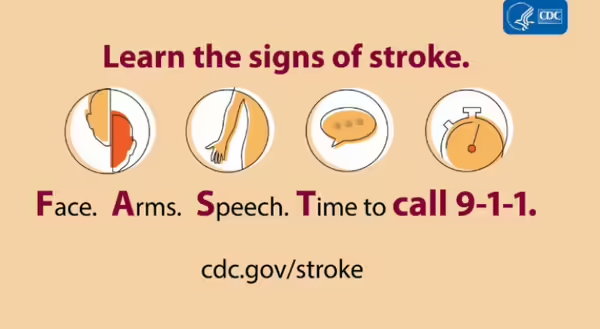
Did you know that May is National Stroke Awareness Month? While we may not think about strokes often, they are one of the leading causes of death and disability worldwide. In fact, someone in the United States has a stroke every 40 seconds.
What exactly is a stroke?
Some strokes occur when a blood vessel becomes blocked by a blood clot or fatty plaques in the blood. The blockage prevents oxygen-rich blood from reaching areas of the brain. Without oxygen, brain cells die. This is called an ischemic stroke.
Other times, an artery in the brain weakens or breaks. Blood leaks out of the artery and pools in the brain, causing pressure to build up and damage brain cells. This is called a hemorrhagic stroke.
Both types of strokes may cause sudden:
-
Weakness or numbness in the face, arm, or leg. This weakness or numbness often affects just one side of the body.
-
Confusion and trouble speaking or understanding speech.
-
Trouble seeing in one or both eyes.
-
Dizziness, a loss of balance, changes in coordination, or trouble walking.
-
Severe headache.
Take action F.A.S.T.
Have you ever heard that you should act F.A.S.T. if you see signs of a stroke? F.A.S.T. is an acronym to help you recognize and respond to strokes promptly. It stands for Face, Arms, Speech, and Time.3 If you think someone may be having a stroke, ask these questions:
-
Does one side of the face droop when smiling?
-
Does one arm drift downward when both arms are raised?
-
Does speech sound strange or slurred?
-
Call 9-1-1 right away if you see any of these signs.
Strokes are always a medical emergency. Always. According to the Centers for Disease Control and Prevention, the chances of surviving a stroke are better when 9-1-1 is called right away.
The CDC reports that some of the most effective treatments for strokes can only be administered during the first three hours after having a stroke. This means that it is not only important to call for help immediately but to also remember the time when you first noticed signs of a stroke.
Calling 9-1-1 is recommended over personal transportation to the E.R. for multiple reasons. One reason is that ambulance personnel know which hospitals are best equipped to treat strokes. Additionally, ambulance personnel can communicate with hospital staff before arriving at the E.R. They can also gather and share important information that may allow the hospital staff to administer treatments more quickly upon arrival.
Closing comments
Recognizing the signs of stroke and taking action F.A.S.T. can save a life. Call 9-1-1 right away if you see signs of a stroke, and try to remember the time when symptoms first began. For more information and helpful resources, visit the American Stroke Association or the Centers for Disease Control and Prevention. And, stay tuned for our next blog with tips for stroke prevention!
Source: This post was written by Lisa Duberowski, Master of Public Health student, working with Kristin Bogdonas, nutrition and wellness educator, serving Henry, Mercer, Rock Island and Stark Counties.
Sources:
-
Centers for Disease Control and Prevention. (2022, October 14). Stroke facts. https://www.cdc.gov/stroke/facts.htm
-
Centers for Disease Control and Prevention. (2022, November 2). About stroke. https://www.cdc.gov/stroke/about.htm
-
Centers for Disease Control and Prevention. (2022, May 4). Stroke signs and symptoms. https://www.cdc.gov/stroke/signs_symptoms.htm
-
Centers for Disease Control and Prevention. (2022, April 5). Treat and recover from stroke. https://www.cdc.gov/stroke/treatments.htm